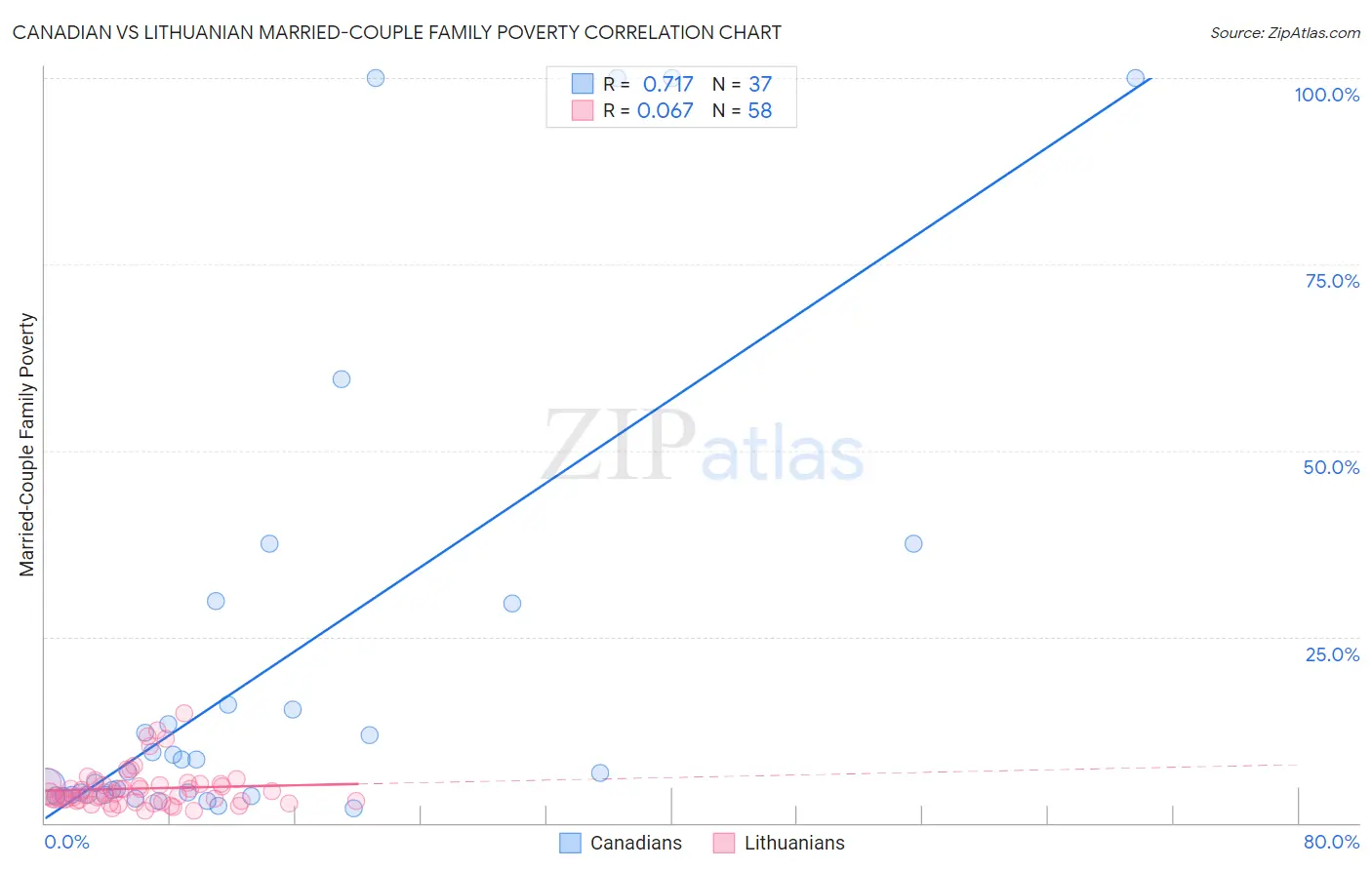Canadian vs Lithuanian Married-Couple Family Poverty
COMPARE
Canadian
Lithuanian
Married-Couple Family Poverty
Married-Couple Family Poverty Comparison
Canadians
Lithuanians
4.5%
MARRIED-COUPLE FAMILY POVERTY
98.8/ 100
METRIC RATING
82nd/ 347
METRIC RANK
4.0%
MARRIED-COUPLE FAMILY POVERTY
100.0/ 100
METRIC RATING
11th/ 347
METRIC RANK
Canadian vs Lithuanian Married-Couple Family Poverty Correlation Chart
The statistical analysis conducted on geographies consisting of 431,987,986 people shows a strong positive correlation between the proportion of Canadians and poverty level among married-couple families in the United States with a correlation coefficient (R) of 0.717 and weighted average of 4.5%. Similarly, the statistical analysis conducted on geographies consisting of 416,141,863 people shows a slight positive correlation between the proportion of Lithuanians and poverty level among married-couple families in the United States with a correlation coefficient (R) of 0.067 and weighted average of 4.0%, a difference of 14.8%.

Married-Couple Family Poverty Correlation Summary
| Measurement | Canadian | Lithuanian |
| Minimum | 2.0% | 1.6% |
| Maximum | 100.0% | 14.7% |
| Range | 98.0% | 13.1% |
| Mean | 20.9% | 4.6% |
| Median | 6.9% | 3.8% |
| Interquartile 25% (IQ1) | 3.7% | 3.0% |
| Interquartile 75% (IQ3) | 22.6% | 5.3% |
| Interquartile Range (IQR) | 18.9% | 2.3% |
| Standard Deviation (Sample) | 30.5% | 2.7% |
| Standard Deviation (Population) | 30.1% | 2.7% |
Similar Demographics by Married-Couple Family Poverty
Demographics Similar to Canadians by Married-Couple Family Poverty
In terms of married-couple family poverty, the demographic groups most similar to Canadians are Immigrants from Denmark (4.6%, a difference of 0.16%), Immigrants from Greece (4.5%, a difference of 0.25%), Immigrants from Croatia (4.6%, a difference of 0.29%), Icelander (4.5%, a difference of 0.39%), and Immigrants from Iran (4.5%, a difference of 0.45%).
| Demographics | Rating | Rank | Married-Couple Family Poverty |
| Cambodians | 99.2 /100 | #75 | Exceptional 4.5% |
| Immigrants | South Africa | 99.1 /100 | #76 | Exceptional 4.5% |
| Immigrants | Latvia | 99.1 /100 | #77 | Exceptional 4.5% |
| Scotch-Irish | 99.1 /100 | #78 | Exceptional 4.5% |
| Immigrants | Iran | 99.0 /100 | #79 | Exceptional 4.5% |
| Icelanders | 99.0 /100 | #80 | Exceptional 4.5% |
| Immigrants | Greece | 98.9 /100 | #81 | Exceptional 4.5% |
| Canadians | 98.8 /100 | #82 | Exceptional 4.5% |
| Immigrants | Denmark | 98.8 /100 | #83 | Exceptional 4.6% |
| Immigrants | Croatia | 98.7 /100 | #84 | Exceptional 4.6% |
| South Africans | 98.7 /100 | #85 | Exceptional 4.6% |
| Immigrants | Turkey | 98.6 /100 | #86 | Exceptional 4.6% |
| Immigrants | North Macedonia | 98.6 /100 | #87 | Exceptional 4.6% |
| Bolivians | 98.6 /100 | #88 | Exceptional 4.6% |
| Immigrants | Czechoslovakia | 98.5 /100 | #89 | Exceptional 4.6% |
Demographics Similar to Lithuanians by Married-Couple Family Poverty
In terms of married-couple family poverty, the demographic groups most similar to Lithuanians are Carpatho Rusyn (3.9%, a difference of 0.51%), Croatian (3.9%, a difference of 0.56%), Bulgarian (4.0%, a difference of 0.70%), Thai (3.9%, a difference of 1.0%), and Latvian (3.9%, a difference of 1.5%).
| Demographics | Rating | Rank | Married-Couple Family Poverty |
| Slovenes | 100.0 /100 | #4 | Exceptional 3.8% |
| Swedes | 100.0 /100 | #5 | Exceptional 3.9% |
| Luxembourgers | 100.0 /100 | #6 | Exceptional 3.9% |
| Latvians | 100.0 /100 | #7 | Exceptional 3.9% |
| Thais | 100.0 /100 | #8 | Exceptional 3.9% |
| Croatians | 100.0 /100 | #9 | Exceptional 3.9% |
| Carpatho Rusyns | 100.0 /100 | #10 | Exceptional 3.9% |
| Lithuanians | 100.0 /100 | #11 | Exceptional 4.0% |
| Bulgarians | 100.0 /100 | #12 | Exceptional 4.0% |
| Czechs | 100.0 /100 | #13 | Exceptional 4.0% |
| Slovaks | 100.0 /100 | #14 | Exceptional 4.0% |
| Poles | 100.0 /100 | #15 | Exceptional 4.0% |
| Germans | 100.0 /100 | #16 | Exceptional 4.0% |
| Filipinos | 100.0 /100 | #17 | Exceptional 4.0% |
| Italians | 100.0 /100 | #18 | Exceptional 4.0% |